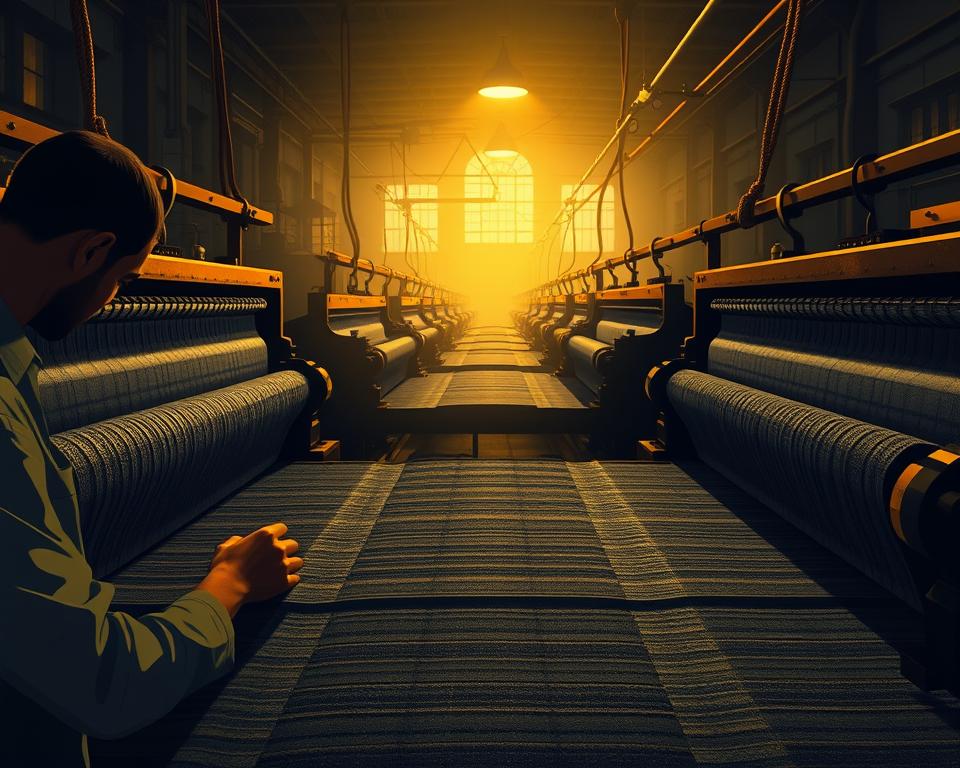Selvedge Denim Material Explained: Everything You Should Know
A lone pair of classic Levi’s 501s dating back to the 1940s commanded $87,400 under the hammer at auction. What caused these jeans to outprice a luxury vehicle? It all comes down to their selvedge denim fabrication.
This premium denim represents more than just fabric. It recalls the era when James Dean donned his 501s in Rebel Without a Cause, and Marlon Brando epitomized cool in The Wild One. Those style icons didn’t merely don jeans. They wore Gold selvedge denim fabric manufacturers crafted on vintage shuttle looms.
Craft denim derives its title from the self-finished perimeters that avert fraying. The word “selvedge” fuses “self” and “edge” to depict this singular weaving approach. In contrast to mass-made denim, every yard of selvedge denim material demands time and craftsmanship.
The texture tells a story through subtle irregularities and natural variations. Every pair acquires character as its indigo wears down. This individual progression renders heritage denim exceptional to collectors and style aficionados alike.
Many believe premium denim lasts longer than regular jeans. The fact is somewhat more complex. Selvedge crafting produces lovely material with tidy edges and robust texture. But strength depends on cotton quality and weight, not just weaving technique. What differentiates artisanal denim is its knack for aging with grace and creating singular fading designs in the long run.
Understanding Selvedge Denim Material
Selvedge denim textile differs from common denim on account of its exclusive construction and self-finished edges. It’s titled after its “self-edge,” a closely woven strip that blocks fraying. This high-grade material signifies allegiance to slow fashion and age-old craft, marking a contrast with mass-made denim.

Decoding Self-Edge Construction
“Selvedge” mixes “self” and “edge,” depicting cloth with a neat, complete border. This narrow selvage appears on both sides of the fabric, doing away with extra finishing. Traditional mills produce it in widths of about 30-32 inches, unlike modern denim’s 60-inch width.
Shuttle Looms and Their Unique Fabric Borders
Shuttle-loomed denim’s essence stems from classic weaving machines operating more slowly. These looms weave a single weft yarn across the warp threads in one motion. This method results in:
- Natural irregular slubs
- A plusher hand-feel versus modern denim
- Securely finished edges that resist fraying
- Genuine irregularities prized by denim fans
Selvedge vs. Standard Denim
Conventional denim is woven on projectile looms sending weft yarns across wider bolts. This method leaves loose threads at the edges, needing overlocked seams to prevent fraying. Selvedge denim fabric, however, requires extra time in production. It delivers enhanced durability and a distinct look, warranting its premium price.
Heritage and Historical Roots of Shuttle-Loomed Denim
The journey of heritage denim started in American textile mills in the 1800s. Shuttle looms were central, weaving material with sealed edges to avoid fraying. That approach yielded indigo-dyed denim slowly and painstakingly, guaranteeing each yard was made with precision. The fabric’s limited width turned into a signature of craft denim making.
American Mills of the 1800s to Today’s Resurgence
For over a century, American mills relied on shuttle looms. Names such as Cone Mills and White Oak furnished top denim to workwear makers. By the 1970s, quick projectile looms dominated, displacing most shuttle machines. This transition was fueled by demand for lower-cost, mass-made denim. Numerous old mills shuttered or updated, letting antique looms sit idle.
How Japan Revived Selvedge Denim
In the 1980s, Japanese manufacturers revived American shuttle looms. The Osaka Five brands led this revival:
- Studio D’Artisan
- Evisu
- Fullcount
- Warehouse
- Denime
These companies merged American vintage style with Japanese precision. They researched antique Levi’s templates, reproducing classic indigo denim textures. By 2000, Japanese makers had overtaken the global artisan denim market.
Why Old-School Weaving Techniques Matter Today
Shuttle looms produce unique fabric characteristics that modern machines can’t match. The slower weaving process allows for irregular textures and deeper indigo penetration. Hardcore denim fans treasure these quirks as proof of real craftsmanship.
| Shuttle Loom Features | Modern Loom Features |
|---|---|
| 29-31 inch fabric width | 60+ inch fabric width |
| 3-4 yards per hour | 15-20 yards per hour |
| Natural irregularities | Uniform texture |
| Self-finished edges | Cut edges requiring overlocking |
Crafting Premium Denim with Vintage Looms
The birth of premium denim begins with shuttle looms’ measured cadence. These machines differ from today’s technology. They pass yarn across the entire width in one thread, sealing edges without extra finishing. This technique assures a crisp, fray-resistant edge on selvedge denim.
Vintage looms weave at a slower pace, producing just 5-6 meters of slub denim daily. This sharply contrasts with current machines that manage 200 meters. The unhurried pace advantages the yarn via:
- Reduced fiber tension yields a gentler feel
- Inherent slubs persist, offering a one-of-a-kind texture
- Uneven surfaces lead to distinctive fading patterns
- Thin widths (about 29–32 inches) minimize trimming waste
Operating these antique machines requires skilled craftsmen. Weavers tweak tension, keep rhythm, and handle fixes. Each loom has its own unique character. Many were built in the 1920s and require know-how passed through the ages. This manual process renders shuttle-loomed denim a genuine craft item.
The slim width of dry denim on antique looms offers a real advantage. Jean makers can use the self-finished edge as the outseam, eliminating waste. This flaunts the cloth’s true craftsmanship. Each bolt tells its own tale, boasting faint differences factory lines can’t duplicate.
Raw Denim vs. Selvedge: Key Distinctions
Many denim enthusiasts confuse raw denim with selvedge denim fabric. This misunderstanding crops up while seeking high-end jeans. The fact is they denote separate facets of denim creation. Understanding this difference guides smarter choices and deeper appreciation of each style’s uniqueness.
Why Not All Selvedge Is Raw
Selvedge indicates the shuttle-loom weave that forms self-finished borders. Raw denim means unwashed fabric straight from the mill. A selvadge raw denim fabric wholesaler might offer both washed and unwashed options. Companies like Naked & Famous craft selvedge jeans, sometimes pre-washed or stretch-infused.
The weaving style is identical. But finishing alters the material’s hand-feel and aesthetic completely.
Washed and Unwashed Denim Compared
All denim starts as dry denim prior to wash. Weavers ship both standard and selvedge bolts unwashed. The main differences are:
- Raw denim forms distinct fade lines with wear
- Pre-washed denim offers instant comfort and stable sizing
- Sanforized raw stays closer to original measurements after first wash
- Unsanforized versions shrink significantly when soaked
Debunking Common Denim Misunderstandings
Not every raw denim is shuttle-loom produced. Contemporary projectile looms likewise churn out unwashed textile. Their appeal converges since consumers prize longevity, customization, and artistry in both selvedge and raw denim. Both types attract denim heads willing to invest time for that perfect custom fade.
Spotting Genuine Selvedge Denim Traits
When hunting for herringbone selvedge denim fabric, identifying authentic selvedge denim is crucial. It distinguishes you from casual shoppers. Authentic selvedge denim features attributes absent in normal denim. Recognizing these markers certifies you’re purchasing genuine premium denim.
Finding the Selvedge ID
Easiest method to confirm selvedge denim? Inspect the outseam. Turn up the cuff and look at the seam along the outside of the leg. Genuine selvedge denim has a clean, finished edge with colored yarns woven into the fabric. Its self-finished perimeter does away with overlock seams used in ordinary denim.
When you cuff your jeans, the selvedge ID becomes visible, adding a unique touch to your style. The colored selvedge threads travel the full outseam, producing that hallmark denim appearance devotees cherish. Regular jeans feature raw edges secured with serger stitches to avoid fraying.
Quality Construction Hallmarks
Quality premium denim is evident through several construction details:
- Dense, uniform weaving free of stray threads
- Neat selvedge borders lacking extra seams
- Uniform edge thread color along the outseam
- Dense fabric weight typical of shuttle-loom production
Rainbow vs Redline Selvedge Distinctions
Rainbow selvedge incorporates varied colored threads in the ID, yielding a vibrant multicolor border. Redline selvedge, the iconic type, employs red threads in the ID and hails from classic U.S. mills. These special selvedge styles command higher prices due to their rarity and visual appeal. Many labels emphasize these traits in their descriptions, simplifying the hunt for real heritage denim.
Why Artisanal Denim Commands Premium Prices
The cost of artisanal denim often shocks newcomers. A pair of selvedge jeans can be three to five times pricier than mass-produced ones.
Comprehending what drives these costs shows the actual value of premium denim.
Shuttle looms weave at a much slower pace than modern machines. While mass-production looms yield fabric swiftly, heritage shuttle looms turn out just 1–2 meters each hour. This deliberate procedure turns a roll of heritage denim into a multi-day project.
The slim selvedge widths increase expenses. Unlike standard denim, which comes in 60-inch widths, premium denim from shuttle looms is just 28-32 inches wide. This narrower width requires more careful cutting and planning to use the fabric efficiently.
Artisanal denim production is small-batch. Suppliers like Okayama’s White Oak and Kuroki emphasize quality rather than scale. They staff master artisans who manage each stage:
- Hand-checking yarn tension
- Adjusting loom settings for each fabric type
- Inspecting every meter for flaws
- Managing rope-dyeing processes that take weeks
These artisans treat denim-making like fine art. They play with distinct yarns and hone indigo-dye recipes handed down through the lineage. By investing in heritage denim, you support mills preserving textile traditions and workers committed to their craft.
Wholesale Choices for Black Selvedge Denim Fabric
The premium denim market has grown beyond Japan’s traditional mills. American brands now compete, providing a wide range of black selvedge denim fabric wholesale. Finding top suppliers means knowing quality indicators and authentic fabric sources.
Finding Quality Suppliers and Manufacturers
Quality suppliers emphasize heritage weaving and a deep passion for craftsmanship. When searching for a selvadge raw denim fabric wholesaler, look for mills that use vintage shuttle looms. They list full specs: fabric heft, weave design, and dye techniques.
Key Gold Selvedge Denim Producers
Gold selvedge denim fabric manufacturers focus on premium colored ID lines, adding luxury to jeans. Top factories craft these niche fabrics in small batches, drawing boutique labels. Their gold-edge thread grants a distinctive finish, setting them apart from common fabrics.
Sourcing Specialty Fabrics Like Nep Denim
Unique textiles such as nep denim require dedicated sourcing paths. Nep denim shows deliberate specks for standout aesthetics. Directly working with mills ensures access to these specialized weaves.
| Fabric Type | Minimum Order | Lead Time | Price Range per Yard |
|---|---|---|---|
| Black Selvedge | 500 yards | 6-8 weeks | $12-18 |
| Gold ID Selvedge | 300 yards | 8-10 weeks | $15-22 |
| Nep Denim | 400 yards | 10-12 weeks | $14-20 |
Selvedge Styles and Variants
The world of selvedge denim fabric goes beyond basic indigo. Currently, manufacturers produce varied textures and designs. These showcase the versatility of shuttle loom weaving. Ranging from faint surface quirks to striking patterns, they deliver one-of-a-kind personality that evolves elegantly with use.
Exploring Slub Denim Texture
Slub denim’s distinctive bumpy texture comes from irregular yarns. They feature thick and thin zones, yielding an organically varied fabric face. Woven on shuttle looms, they form slub-textured selvedge that fades unpredictably.
Each slub denim jean yields its own one-off wear pattern. The raised areas wear differently than the smooth sections, making each pair distinct.
Herringbone Selvedge Denim Fabric Characteristics
Herringbone selvedge cloth sports a zigzag weave reminiscent of fish skeletons. The pattern forms diagonal ribs that reverse direction periodically. This motif boosts aesthetics and reinforces the cloth’s durability.
Brands like Iron Heart and The Strike Gold routinely utilize this weave in their top-tier offerings.
Understanding Striped Denim & Specialty Weaves
Striped denim uses alternating threads to form vertical or horizontal stripes. Factories weave these patterns by switching colored threads as they work. Some popular variations include:
- Hickory stripe with alternating indigo and white
- Railroad stripe featuring thin pinstripes
- Wabash stripe with printed dots over stripes
| Fabric Type | Visual Pattern | Fade Characteristics |
|---|---|---|
| Slub Denim | Bumpy, irregular surface | High contrast, uneven fading |
| Herringbone | Zigzag diagonal lines | Subtle vertical streaking |
| Striped Denim | Alternating color bands | Pattern remains visible after fading |
Maintaining Your Heritage Denim
Heritage denim needs particular attention to evolve its distinct personality. Unlike regular jeans, raw denim and dry denim transform with wear. They form custom fade stories unique to you.
Your first few wears in artisan denim might feel firm and odd. That’s perfectly normal. The fabric needs time to soften and mold to your body shape. Some denim enthusiasts speed up this process by wearing their jeans in the shower or doing squats while damp. Others opt for a gradual, more organic break-in.
Raw denim develops its best fades when you wait to wash it. Skin oils and regular friction form whiskers by the knees and honeycombs at the rear. Many wearers wait six months for the first wash, and some even a year. That patience rewards you with bold, custom fades matching your motion.
When washing dry denim, flip it and rinse in cold water. Forego spin and drip-dry in shade. Others opt for gentle hand-wash in a bathtub using a soft detergent. Steer clear of hot water and tumble drying, which may shrink and dull fades.
Your heritage denim investment grows more valuable with proper care. Each wear adds character, making your jeans truly one-of-a-kind. The rigid start transforms into a comfortable second skin that reflects your lifestyle and movement patterns.
Where to Buy Quality Indigo-Dyed Denim Today
Selvedge denim’s comeback has created fresh opportunities for fans. Large chains now offer indigo denim, while niche shops continue premium slow-fashion offerings. This allows consumers to find authentic selvedge options at various price points, catering to different budgets and styles.
Levi’s offers their 501 Original Fit Selvedge Jeans for $148, making heritage craftsmanship accessible to a wider audience. Uniqlo carries Selvedge Straight Jeans for $50, drawing budget-conscious style seekers. For upscale choices, Buck Mason presents Japanese Loom State Selvedge Full-Saddle Jeans at $248. Iron Heart elevates artisan denim with its 634s-18 Vintage Denim for $385, sold at Self Edge.
American brands like Todd Snyder and Buck Mason now compete with Japanese specialists in the selvedge denim market. They realize that classic weaving methods and excellence underpin slow-fashion success. Online or offline, good indigo-dyed denim is easier than ever for American shoppers devoted to genuine craft.

